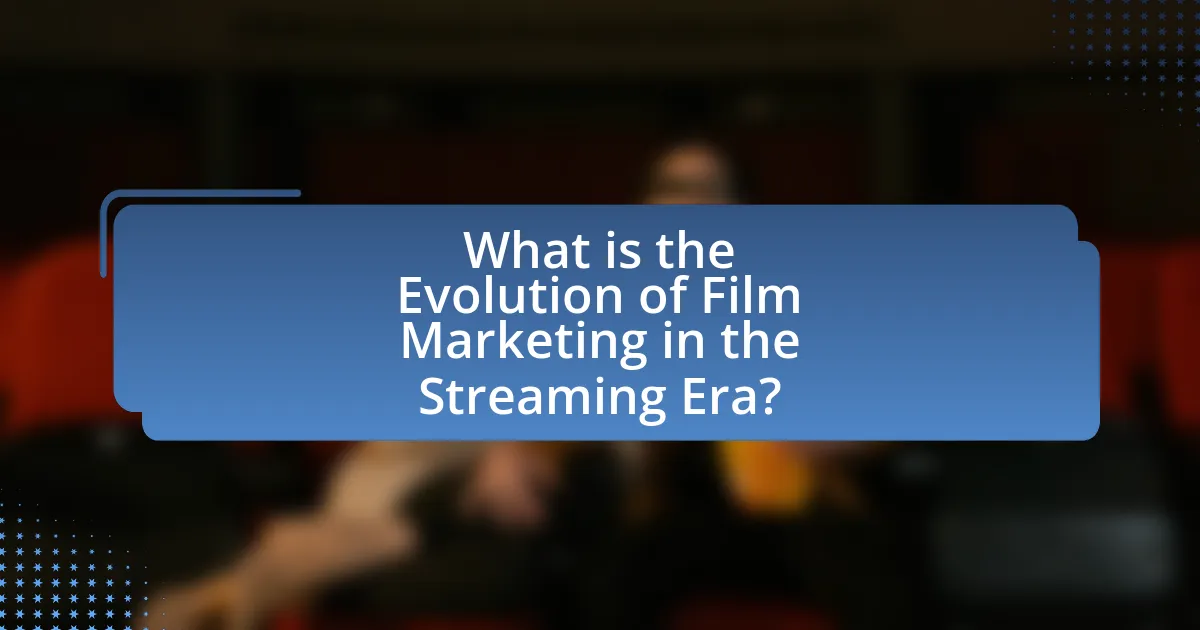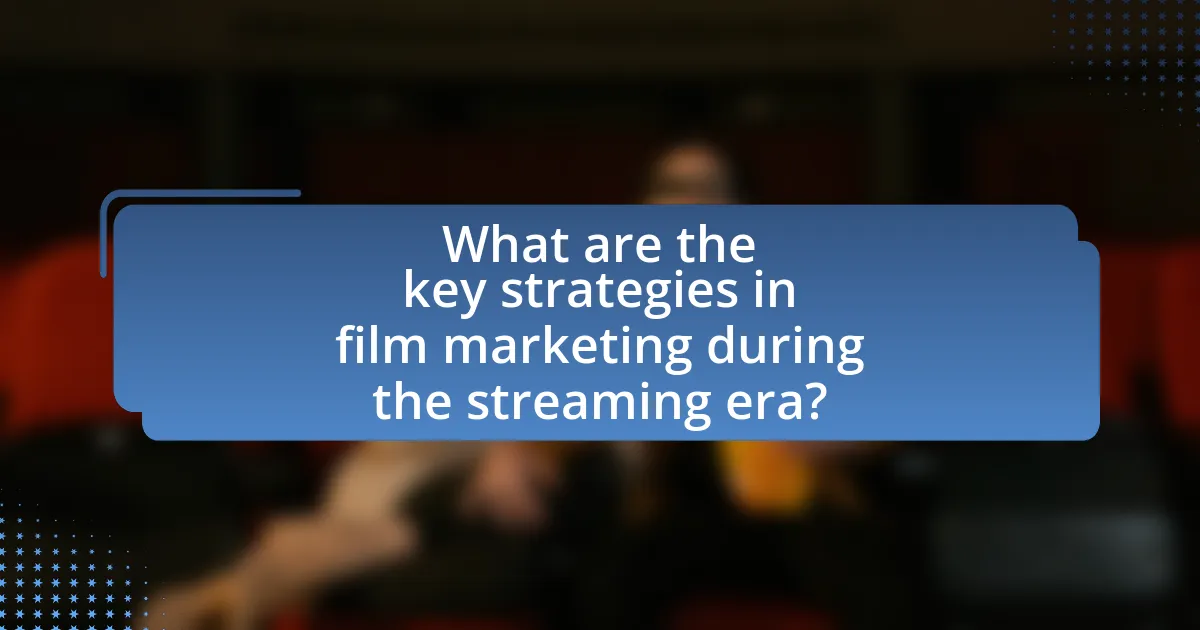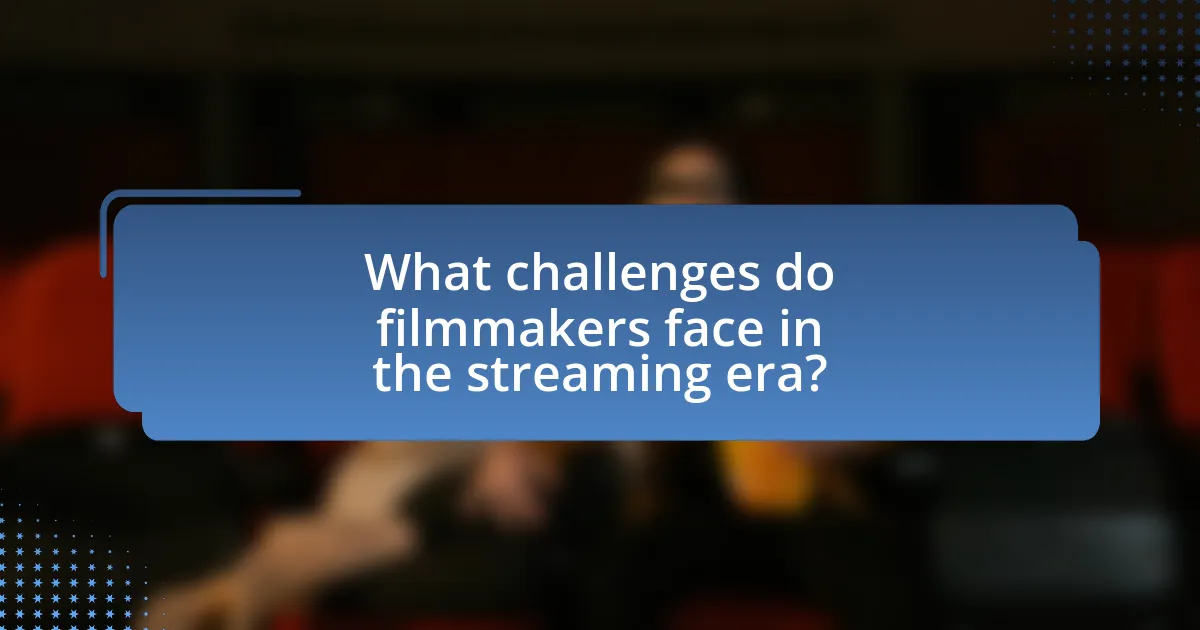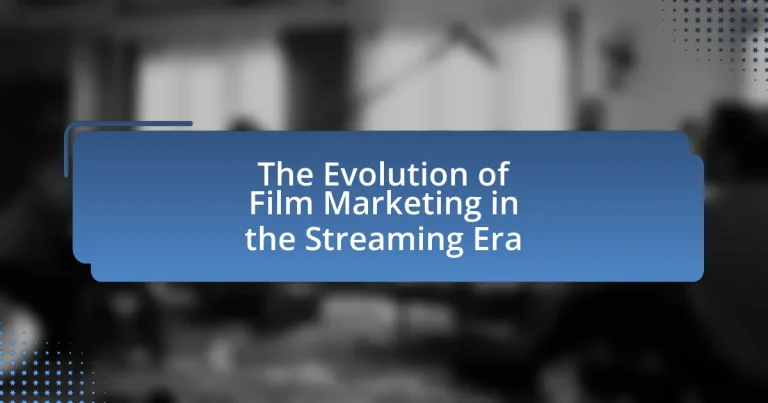The article examines the evolution of film marketing in the streaming era, highlighting the shift from traditional marketing methods to digital-first strategies driven by platforms like Netflix and Amazon Prime Video. It discusses how targeted online advertising, social media engagement, and data analytics have transformed promotional tactics, emphasizing the importance of personalized marketing campaigns. Key differences between traditional and streaming film marketing are outlined, along with the impact of audience behaviors on marketing strategies. The article also addresses the implications for filmmakers, including independent creators, and offers insights into effective marketing practices and emerging trends in the competitive streaming landscape.

What is the Evolution of Film Marketing in the Streaming Era?
The evolution of film marketing in the streaming era has shifted from traditional methods to digital-first strategies. Streaming platforms like Netflix and Amazon Prime Video have transformed how films are promoted, emphasizing targeted online advertising, social media engagement, and data analytics to reach specific audiences. For instance, Netflix utilizes viewer data to tailor marketing campaigns, resulting in a 30% increase in viewer engagement for films that leverage personalized promotions. Additionally, the rise of influencer marketing and partnerships with social media platforms has become crucial, as seen in campaigns for films like “Bird Box,” which generated significant buzz through viral challenges. This transition reflects a broader trend where film marketing increasingly relies on digital channels to effectively engage audiences in a competitive landscape.
How has film marketing changed with the rise of streaming platforms?
Film marketing has shifted significantly with the rise of streaming platforms, emphasizing digital strategies over traditional methods. Streaming services like Netflix and Amazon Prime Video have enabled targeted advertising and personalized content recommendations, allowing marketers to reach specific audiences more effectively. For instance, a 2021 report by PwC indicated that 70% of consumers prefer personalized ads, demonstrating the effectiveness of data-driven marketing strategies in the streaming landscape. Additionally, the immediacy of social media platforms has transformed promotional tactics, with real-time engagement and influencer partnerships becoming crucial for generating buzz around new releases. This evolution reflects a broader trend where traditional marketing approaches are increasingly supplemented or replaced by digital-first strategies tailored to the streaming audience.
What are the key differences between traditional and streaming film marketing?
Traditional film marketing primarily relies on physical media, such as posters, billboards, and television advertisements, while streaming film marketing utilizes digital platforms, social media, and targeted online advertising. Traditional marketing often focuses on broad audience reach through mass media, whereas streaming marketing emphasizes data-driven strategies to target specific demographics based on viewing habits and preferences. For instance, streaming platforms like Netflix and Hulu leverage user data to personalize marketing campaigns, resulting in higher engagement rates. Additionally, traditional marketing campaigns typically have a fixed timeline leading up to a film’s release, while streaming marketing can be more flexible, allowing for ongoing promotion even after a film’s debut.
How have audience behaviors influenced film marketing strategies?
Audience behaviors have significantly influenced film marketing strategies by driving a shift towards data-driven approaches and personalized content. As streaming platforms collect extensive viewer data, marketers analyze audience preferences, viewing habits, and engagement metrics to tailor promotional campaigns. For instance, Netflix utilizes algorithms to recommend films based on user behavior, which informs targeted advertising and content creation. This strategy has been validated by a 2021 report from Deloitte, which found that 80% of consumers are more likely to engage with personalized marketing. Consequently, understanding audience behaviors has become essential for optimizing marketing efforts and enhancing viewer retention in the competitive streaming landscape.
Why is understanding this evolution important for filmmakers?
Understanding the evolution of film marketing in the streaming era is crucial for filmmakers because it directly influences their ability to reach and engage audiences effectively. As consumer behavior shifts towards streaming platforms, filmmakers must adapt their marketing strategies to leverage digital channels, social media, and data analytics to maximize visibility and audience connection. For instance, a study by PwC indicates that streaming services are projected to account for 55% of the global box office by 2024, highlighting the necessity for filmmakers to understand these trends to remain competitive. This knowledge enables filmmakers to craft targeted campaigns that resonate with viewers, ultimately enhancing their films’ success in a rapidly changing landscape.
What implications does this evolution have for independent filmmakers?
The evolution of film marketing in the streaming era significantly impacts independent filmmakers by providing them with greater access to global audiences and distribution channels. This shift allows independent filmmakers to leverage platforms like Netflix, Amazon Prime, and Hulu, which have democratized film distribution, enabling them to reach viewers without the need for traditional theatrical releases. According to a 2021 report by the Motion Picture Association, streaming services accounted for over 80% of the film industry’s revenue growth, highlighting the importance of these platforms for independent films. Additionally, social media marketing strategies have become essential, allowing filmmakers to engage directly with audiences, build communities, and promote their work at a fraction of the cost of traditional marketing methods. This evolution ultimately empowers independent filmmakers to compete more effectively in a crowded marketplace.
How can established studios adapt to the new marketing landscape?
Established studios can adapt to the new marketing landscape by leveraging data analytics and targeted digital marketing strategies. By utilizing data analytics, studios can gain insights into audience preferences and viewing habits, allowing them to tailor their marketing campaigns effectively. For instance, a study by PwC indicates that 70% of consumers prefer personalized content, which underscores the importance of targeted marketing. Additionally, established studios should embrace social media platforms and influencer partnerships to reach younger demographics, as 54% of social media users report discovering new films through these channels. This strategic shift towards data-driven and digital-first marketing approaches enables studios to remain competitive in the evolving streaming era.

What are the key strategies in film marketing during the streaming era?
Key strategies in film marketing during the streaming era include targeted digital advertising, social media engagement, and leveraging data analytics. Targeted digital advertising allows filmmakers to reach specific demographics through platforms like Google Ads and social media, increasing the likelihood of attracting the right audience. Social media engagement fosters community building and word-of-mouth promotion, with platforms like Instagram and TikTok being particularly effective for reaching younger viewers. Additionally, leveraging data analytics enables marketers to understand viewer preferences and behaviors, allowing for more personalized marketing campaigns. For instance, Netflix uses viewer data to inform its promotional strategies, tailoring content recommendations and advertisements to individual users, which has proven effective in increasing viewer retention and engagement.
How do social media campaigns impact film marketing?
Social media campaigns significantly enhance film marketing by increasing audience engagement and expanding reach. These campaigns leverage platforms like Facebook, Instagram, and Twitter to create buzz around a film, allowing studios to target specific demographics effectively. For instance, a study by the American Film Institute found that films with active social media campaigns saw a 20% increase in box office revenue compared to those without. Additionally, social media allows for real-time feedback and interaction, enabling filmmakers to adjust marketing strategies based on audience reactions. This dynamic approach not only fosters a community around the film but also drives ticket sales and streaming views, demonstrating the critical role of social media in modern film marketing.
What platforms are most effective for film promotion?
Social media platforms, particularly Facebook, Instagram, and Twitter, are the most effective for film promotion. These platforms allow filmmakers to engage directly with audiences, share trailers, behind-the-scenes content, and host live Q&A sessions, which can significantly boost visibility and interest. For instance, a study by the American Film Institute found that films promoted through social media campaigns saw a 30% increase in audience turnout compared to those that relied solely on traditional marketing methods. Additionally, platforms like YouTube are crucial for hosting trailers and promotional videos, reaching millions of potential viewers.
How can filmmakers leverage influencers in their marketing efforts?
Filmmakers can leverage influencers in their marketing efforts by collaborating with them to reach targeted audiences and enhance engagement. Influencers possess established trust and credibility with their followers, which filmmakers can utilize to promote their films effectively. For instance, a study by the Digital Marketing Institute found that 49% of consumers depend on influencer recommendations when making purchase decisions, highlighting the potential impact of influencer partnerships. By creating tailored content that resonates with the influencer’s audience, filmmakers can increase visibility and drive interest in their projects, ultimately leading to higher viewership and box office success.
What role does data analytics play in modern film marketing?
Data analytics plays a crucial role in modern film marketing by enabling studios to make data-driven decisions that enhance audience targeting and campaign effectiveness. By analyzing viewer preferences, engagement metrics, and social media trends, filmmakers can tailor their marketing strategies to specific demographics, increasing the likelihood of box office success. For instance, a study by PwC found that 70% of film executives believe data analytics significantly improves their marketing strategies, allowing for more precise targeting and resource allocation. This data-driven approach not only optimizes marketing budgets but also enhances the overall viewer experience by delivering content that resonates with audiences.
How can audience data inform marketing decisions?
Audience data can inform marketing decisions by providing insights into viewer preferences, behaviors, and demographics, which enable targeted strategies. For instance, streaming platforms like Netflix utilize audience data to analyze viewing habits, allowing them to tailor marketing campaigns that resonate with specific audience segments. A study by McKinsey & Company found that companies leveraging audience insights can achieve up to 10-20% higher conversion rates in their marketing efforts. This data-driven approach ensures that marketing messages are relevant and effective, ultimately enhancing audience engagement and driving subscriptions.
What tools are available for analyzing film marketing effectiveness?
Tools available for analyzing film marketing effectiveness include social media analytics platforms, audience measurement tools, and marketing attribution software. Social media analytics platforms, such as Hootsuite and Sprout Social, allow marketers to track engagement metrics and audience sentiment across various channels. Audience measurement tools like Nielsen and Comscore provide insights into viewership demographics and behaviors, helping to assess the impact of marketing campaigns. Marketing attribution software, such as Google Analytics and HubSpot, enables marketers to understand which channels and campaigns drive conversions, providing a clearer picture of overall marketing effectiveness. These tools collectively offer data-driven insights that are essential for evaluating the success of film marketing strategies in the streaming era.

What challenges do filmmakers face in the streaming era?
Filmmakers face significant challenges in the streaming era, primarily due to increased competition and changing audience behaviors. The proliferation of streaming platforms has led to an oversaturated market, making it difficult for individual films to stand out. According to a report by PwC, the global streaming market is expected to reach $100 billion by 2025, indicating a rapid growth in content availability. This saturation results in a struggle for filmmakers to secure visibility and attract viewers amidst a vast array of options. Additionally, filmmakers must adapt to evolving consumer preferences, as audiences increasingly favor binge-watching and on-demand content over traditional release schedules. This shift complicates marketing strategies, requiring filmmakers to innovate in how they promote their work to engage viewers effectively.
How does competition among streaming services affect film marketing?
Competition among streaming services significantly influences film marketing strategies. As platforms like Netflix, Amazon Prime, and Disney+ vie for viewer attention, they adopt aggressive marketing tactics, including high-profile advertising campaigns, exclusive content releases, and strategic partnerships. For instance, Netflix’s investment in original content and targeted social media promotions has been shown to increase subscriber engagement and retention, as evidenced by their reported growth of over 200 million subscribers by 2021. This competitive landscape compels filmmakers and studios to innovate their marketing approaches, utilizing data analytics to tailor campaigns to specific audience segments, thereby enhancing the effectiveness of their promotional efforts.
What strategies can filmmakers use to stand out in a crowded market?
Filmmakers can stand out in a crowded market by leveraging unique storytelling, innovative marketing techniques, and audience engagement strategies. Unique storytelling involves creating original narratives that resonate with specific demographics, which can attract niche audiences and generate word-of-mouth promotion. Innovative marketing techniques, such as utilizing social media platforms for targeted advertising and interactive content, can enhance visibility and engagement. Additionally, filmmakers can foster audience engagement through community-building initiatives, such as behind-the-scenes content and interactive Q&A sessions, which create a loyal fan base. These strategies have been effective in recent years, as evidenced by films like “The Blair Witch Project,” which utilized grassroots marketing to achieve significant box office success despite a limited budget.
How do changing viewer preferences complicate marketing efforts?
Changing viewer preferences complicate marketing efforts by creating a dynamic landscape where audience tastes and consumption habits shift rapidly. This variability requires marketers to continuously adapt their strategies to remain relevant, as traditional methods may no longer resonate with viewers who increasingly favor personalized content and diverse platforms. For instance, a 2021 survey by Deloitte found that 80% of consumers prefer streaming services that offer tailored recommendations, indicating a significant shift from passive viewing to active engagement. Consequently, marketers must invest in data analytics and audience segmentation to effectively target their campaigns, which can strain resources and complicate planning.
What are the future trends in film marketing for streaming platforms?
Future trends in film marketing for streaming platforms include increased personalization through data analytics, the use of social media influencers, and immersive experiences like virtual reality. Streaming services are leveraging viewer data to tailor marketing campaigns, ensuring that content reaches the right audience effectively. For instance, platforms like Netflix utilize algorithms to analyze user preferences, which informs targeted advertising strategies. Additionally, collaborations with social media influencers have proven effective in reaching niche audiences, as seen with promotional campaigns for films like “Bird Box.” Immersive experiences, such as virtual reality trailers or interactive content, are also gaining traction, enhancing viewer engagement and creating buzz around new releases. These trends reflect a shift towards more dynamic and audience-centric marketing approaches in the streaming landscape.
How might emerging technologies influence film marketing strategies?
Emerging technologies significantly influence film marketing strategies by enabling more targeted and interactive campaigns. For instance, advancements in data analytics allow marketers to analyze viewer preferences and behaviors, leading to personalized marketing efforts that resonate with specific audience segments. Additionally, the rise of social media platforms and augmented reality (AR) tools facilitates immersive promotional experiences, such as virtual reality trailers or interactive social media campaigns, which engage audiences more effectively. According to a 2021 report by PwC, 70% of consumers are more likely to engage with brands that utilize AR in their marketing, demonstrating the effectiveness of these technologies in enhancing viewer engagement and driving ticket sales.
What can filmmakers learn from successful case studies in streaming marketing?
Filmmakers can learn the importance of targeted audience engagement from successful case studies in streaming marketing. For instance, Netflix’s marketing strategy for “Bird Box” utilized social media challenges and viral marketing to create buzz, resulting in over 45 million views in its first week. This demonstrates that understanding audience behavior and leveraging platforms where they engage can significantly enhance visibility and viewership. Additionally, case studies show that personalized marketing, such as tailored recommendations based on viewing history, can increase viewer retention and satisfaction, as evidenced by Amazon Prime’s targeted campaigns that led to a 30% increase in user engagement. These insights highlight the necessity for filmmakers to adopt data-driven strategies and innovative marketing techniques to thrive in the competitive streaming landscape.
What best practices should filmmakers follow in the streaming era?
Filmmakers should prioritize audience engagement and data-driven marketing strategies in the streaming era. Engaging with audiences through social media platforms and interactive content fosters community and loyalty, which is essential for success in a crowded market. Additionally, utilizing analytics to understand viewer preferences and behaviors allows filmmakers to tailor their marketing efforts effectively. For instance, a study by PwC indicates that 63% of consumers prefer personalized content recommendations, highlighting the importance of data in shaping marketing strategies. By focusing on these best practices, filmmakers can enhance visibility and drive viewership in the competitive streaming landscape.
How can filmmakers effectively engage their target audience?
Filmmakers can effectively engage their target audience by utilizing data-driven marketing strategies that tailor content to viewer preferences. By analyzing audience demographics, viewing habits, and feedback, filmmakers can create targeted promotional campaigns that resonate with specific groups. For instance, a study by the Motion Picture Association found that 80% of viewers prefer personalized content recommendations, highlighting the importance of understanding audience interests. Additionally, leveraging social media platforms for interactive engagement, such as behind-the-scenes content and live Q&A sessions, fosters a sense of community and connection with the audience. This approach not only enhances viewer loyalty but also increases the likelihood of word-of-mouth promotion, which is crucial in the competitive streaming landscape.
What common pitfalls should filmmakers avoid in their marketing campaigns?
Filmmakers should avoid several common pitfalls in their marketing campaigns, including neglecting audience research, failing to establish a clear brand identity, and underestimating the power of social media engagement. Neglecting audience research can lead to misaligned marketing strategies that do not resonate with potential viewers, resulting in wasted resources. Establishing a clear brand identity is crucial; without it, filmmakers risk confusing their audience and diluting their message. Underestimating social media engagement can limit a film’s reach, as platforms like Instagram and Twitter are essential for building buzz and connecting with audiences. According to a 2021 study by the American Film Market, films that actively engaged with audiences on social media saw a 30% increase in viewership compared to those that did not.


